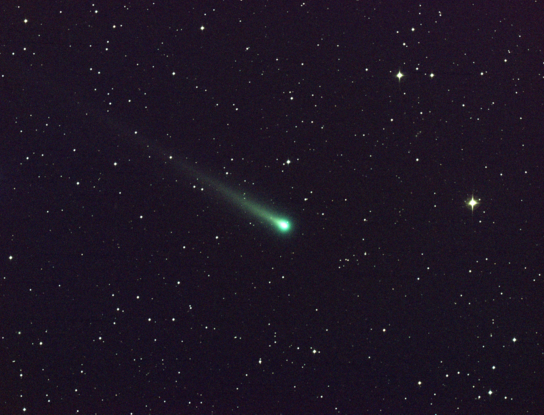By Ana Verayo, | March 28, 2016

The so called twin comets came the closest icy rocks to pass by the planet in two centuries.
Two comets passed by Earth last week but within a safe distance of two to three million miles away from the planet as scientists began to monitor Comet 252P/LINEAR and observed something strange happening to the comet.
Like Us on Facebook
The icy space rock began to brighten a few weeks ago, suddenly transforming into 100 times brighter than it was originally, according to Sky and Telescope. This resulted in observations from the Southern Hemisphere where the comet appeared to be about 750 feet in size from the skies. Viewers also directly saw that the comet seem to possess an eerie greenish glow.
Beginning Tuesday, viewers from the Northern Hemisphere who are equipped with binoculars can now spot Comet 252P/Linear in the night skies but astronomers also advise that the view will not become as clear as the luminosity of the moon due to light pollution.
In order for stargazers to see this comet, it is advisable to be out a few hours before the sun rises in an area as far from light pollution from city light to gain a better view. After settling down to a nice, dark spot outside, locate the Sagittarius and Scorpius constellations and focus on that low region in the southern part of the sky. Astronomers say that the comet is expected to zip by between the two constellations.
Apart from locating the constellations, another strategy is to locate Saturn and Mars in the night sky along with a bright star known as Antares, as they form a distinct triangle shape in the sky. The comet will be accelerating from the left of this triangle that will be in line with Mars and Saturn during the morning of March 29 and along a connection between Saturn and Antares on March 31.
According to Sky and Telescope's senior editor Kelly Beatty, comet LINEAR will not be so obvious with a tail as its light is not concentrated in a single point but is emanating around a soft glow that is larger than the moon but thousands of times more dim.
Astronomers say that the duration of visibility of the comet since its passed by Earth last March 21 some 3.3 million miles away is still unknown, as it is now moving away from Earth and the sun.
The second comet known as PanSTARRS (P/2016 BA14) passed closer to Earth at 2.2 million miles away last March 22 however, astronomers say that it was visible from Earth's skies but it was too faint to see with the naked eye unless viewed with a telescope. This comet can still be seen crossing the skies however a good telescope is required.
Scientists consider the two comets as twins as they both possess similar orbits. The two comets also have similar sizes where P/2016 BA14 is almost half the size of comet 252P/LINEAR, suggesting that they could have possibly originated from the same larger asteroid collision.
-
Use of Coronavirus Pandemic Drones Raises Privacy Concerns: Drones Spread Fear, Local Officials Say

-
Coronavirus Hampers The Delivery Of Lockheed Martin F-35 Stealth Fighters For 2020

-
Instagram Speeds Up Plans to Add Account Memorialization Feature Due to COVID-19 Deaths

-
NASA: Perseverance Plans to Bring 'Mars Rock' to Earth in 2031

-
600 Dead And 3,000 In The Hospital as Iranians Believed Drinking High-Concentrations of Alcohol Can Cure The Coronavirus

-
600 Dead And 3,000 In The Hospital as Iranians Believed Drinking High-Concentrations of Alcohol Can Cure The Coronavirus

-
COVID-19: Doctors, Nurses Use Virtual Reality to Learn New Skills in Treating Coronavirus Patients







